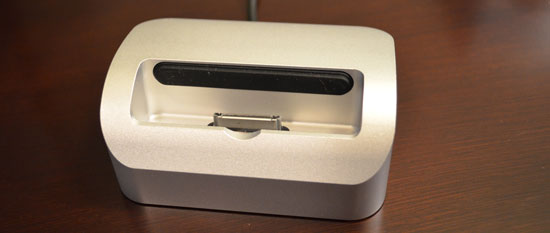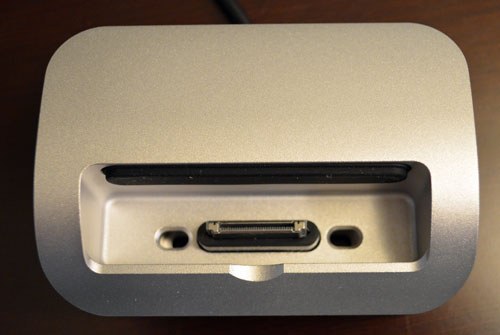Elevation Lab started with a simple idea, make a sturdy iPhone dock that can be used while the phone is still in a case and reduces the dock connector friction so the phone can be easily docked and un-docked. Sounds easy right? It isn’t. Let’s take a look at the form and function of the Elevation Dock for iPhone. There are a few keys to what makes the Elevation Dock work. The first is that it has a bit of heft to it thanks to being milled from solid billets of aluminum. This is key when trying to get the phone out of the dock. The Apple dock connector naturally and purposely has a tight fit between peripherals and the phone to ensure that the two stay suck together. But when wanting to grab the phone and go when it’s in a dock this would cause the dock to go flying if it didn’t provide low friction and some weight.
When inserting the phone it’s a simple matter of gently pushing it straight down onto the dock connector. Not much force is required and the phone with buzz or chime, depending on the the silent switch position, when a connection is made. Removing the phone is just as easy, pull straight up and the phone easily slides off the dock connector.
The initial setup will depend on the case thickness and power outlet location. The black rubber bar at the back of the phone well is reversible. The above picture shows it in the deeper configuration. The dock originally arrived with the rubber piece extending further out so that the well was not as deep for phones with no case or a very thin case. No tools are required for the rubber back stop changes.
The factory configuration for the power connector is a short USB dongle. If the dock is being connected to a computer this would work well. But for situations where an electrical outlet is further away the external power adapter and extended USB cable need to be attached. An Allen wrench is included for this purpose. To attach the optional longer USB cable, remove the two screws on that secure the bottom plate and pop off the plate. This exposes a small circuit board and a micro-USB connector. Pull the USB cable straight out and swap it or the longer cable. Then re-attach the bottom plate.
The power adapter is small and light, it works best on the end of a power strip since it aligns parallel with a strip as opposed to the more useful perpendicular arrangement. The optional cable was long enough to wrap behind a night stand and plug into a nearby surge protector. Though longer after-market USB cables can be easily found.
This dock was purchased as part of a Kickstarter project, but the Elevation Lab store now has two varieties of the dock for pre-order. A standard version for $90 and a plus version of the dock adds an audio output jack and power adapter for $120.
Photos © Crasstalk.


